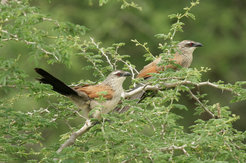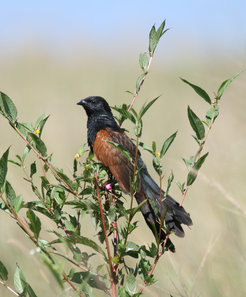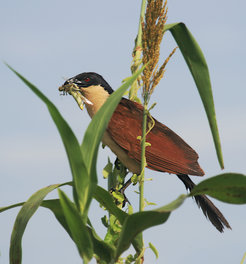Ecophysiology and evolution of sex roles in monogamous and polyandrous coucals


Black coucals (Centropus grillii), white-browed coucals (C. superciliosus) and coppery-tailed coucals (C. cupreicaudus) breed in the swampy grasslands of sub-Saharan Africa. In some places the closely related species occur in the same habitat and breed during the same time of the year, often in close proximity to one another. But they show extreme differences in their mating system.
White-browed and coppery-tailed coucals are socially monogamous, which means that one female and one male form a pair and sing duets. Both females and males incubate the eggs and feed the young. Black coucals are sex-roles are reversed: Females are almost twice as large as males; each female sings and defends a large territory, in which she 'pairs' with up to 5 males simultaneously (polyandry). In contrast, male black coucals rarely sing, but incubate the eggs and feed the young without any help from the female.

Which ecological and evolutionary factors have led to the dramatic differences in behaviour and life histories of these three coucal species? And which physiological mechanisms drive the differences in behaviour? To approach these evolutionary and eco-physiological questions we study individually colour- and radiotagged coucals in the Usangu Plains, Tanzania.
___________________________________________
Selected publications of the coucal project
Goymann, W.: Males paving the road to polyandry? Parental compensation in a monogamous nesting cuckoo and a classical polyandrous relative. Ethology 126 (4), pp. 436 - 444 (2020) DOI
Safari, I.; Goymann, W.; Kokko, H.: Male-only care and cuckoldry in black coucals: Does parenting hamper sex life? Proceedings of the Royal Society B: Biological Sciences 286 (1900), 20182789 (2019) DOI
Safari, I.; Goymann, W.: Certainty of paternity in two coucal species with divergent sex roles: The devil takes the hindmost. BMC Evolutionary Biology 18, 110 (2018) DOI
Brumm, H.; Goymann, W.: On the natural history of duetting in White-browed Coucals: Sex- and body-size-dependent differences in a collective vocal display. Journal of Ornithology 158 (3), pp. 669 - 678 (2017) DOI
Goymann, W.; Safari, I.; Muck, C.; Schwabl, I.: Sex roles, parental care and offspring growth in two contrasting coucal species. Royal Society Open Science 3 (10), 160463 (2016) DOI
Goymann, W.; Makomba, M.; Urasa, F.; Schwabl, I.: Social monogamy vs. polyandry: Ecological factors associated with sex roles in two closely related birds within the same habitat. Journal of Evolutionary Biology 28 (7), pp. 1335 - 1353 (2015) DOI
Geberzahn, N.; Goymann, W.; ten Cate, C.: Threat signaling in female song-evidence from playbacks in a sex-role reversed bird species. Behavioral Ecology 21 (6), pp. 1147 - 1155 (2010) DOI
Goymann, W.; Wittenzellner, A.; Schwabl, I.; Makomba, M.: Progesterone modulates aggression in sex-role reversed female African black coucals. Proceedings of the Royal Society B: Biological Sciences 275 (1638), pp. 1053 - 1060 (2008) DOI
Voigt, C.; Goymann, W.: Sex-role reversal is reflected in the brain of African black coucals (Centropus grillii). Developmental Neurobiology 67 (12), pp. 1560 - 1573 (2007) DOI
Goymann, W.; Wingfield, J. C.: Competing females and caring males. Sex steroids in African black coucals, Centropus grillii. Animal Behaviour 68 (4), pp. 733 - 740 (2004) DOI
Goymann, W.; Wittenzellner, A.; Wingfield, J. C.: Competing females and caring males. Polyandry and sex-role reversal in African black coucals, Centropus grillii. Ethology 110 (10), pp. 807 - 823 (2004) DOI


